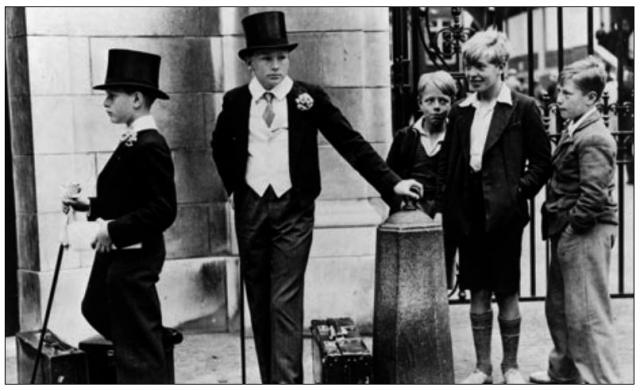By Andrew Gavin Marshall,
AndrewGavinMarshall.com.
The Global Power Project,
an investigative series produced by Occupy.com, aims to identify and
connect the worldwide institutions and individuals who comprise today’s
global power oligarchy. By studying the relationships and varying levels
of leadership that govern our planet’s most influential institutions —
from banks, corporations and financial institutions to think tanks,
foundations and universities — this project seeks to expose the complex,
highly integrated network of influence wielded by relatively few
individuals on a national and transnational basis. This is not a study
of wealth, but a study of power.
Many now know the rhetoric of the 1% very well: the imagery of a
small elite owning most of the wealth while the 99% take the table
scraps. This rhetoric and imagery was made popular by the growth of the
Occupy movement, so it seems appropriate that a project of
Occupy.com should expand on this understanding and bring the activities of the global elite further to light.
In 2006,
a UN report revealed
that the world’s richest 1% own 40% of the world’s wealth, with those
in the financial and internet sectors comprising the “super rich.” More
than a third of the world’s super-rich live in the U.S., with roughly
27% in Japan, 6% in the U.K., and 5% in France. The world’s richest 10%
accounted for roughly 85% of the planet’s total assets, while the bottom
half of the population – more than 3 billion people – owned less than
1% of the world’s wealth.
Looking specifically at the United States, the top 1% own more than
36% of the national wealth and more than the combined wealth of the
bottom 95%. Almost all of the wealth gains over the previous decade went
to the top 1%. In the mid-1970s, the top 1% earned 8% of all national
income; this number rose to 21% by 2010. At the highest sliver at the
top, the 400 wealthiest individuals in America have more wealth than the
bottom 150 million.
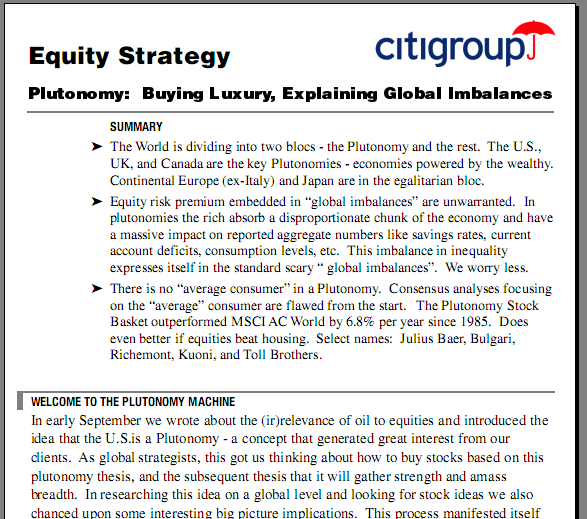 A 2005 report from Citigroup
A 2005 report from Citigroup coined
the term “plutonomy” to describe countries “where economic growth is
powered by and largely consumed by the wealthy few.” The report
specifically identified the U.K., Canada, Australia and the United
States as four plutonomies. Published three years before the onset of
the financial crisis in 2008, the Citigroup report stated: “Asset booms,
a rising profit share and favorable treatment by market-friendly
governments have allowed the rich to prosper and become a greater share
of the economy in the plutonomy countries.”
“The rich,” said the report, “are in great shape, financially.”
In early 2013, Oxfam reported that the fortunes made by the world’s
100 richest people over the course of 2012 – roughly $240 billion –
would be enough to lift the world’s poorest people out of poverty four
times over. In
the Oxfam report,
“The Cost of Inequality: How Wealth and Income Extremes Hurt Us All,”
the international charity noted that in the past 20 years, the richest
1% had increased their incomes by 60%. Barbara Stocking, an Oxfam
executive, noted that this type of extreme wealth is “economically
inefficient, politically corrosive, socially divisive and
environmentally destructive…We can no longer pretend that the creation
of wealth for a few will inevitably benefit the many – too often the
reverse is true.”
The report added: “In the UK, inequality is rapidly returning to
levels not seen since the time of Charles Dickens. In China the top 10%
now take home nearly 60% of the income. Chinese inequality levels are
now similar to those in South Africa, which is now the most unequal
country on Earth and significantly more unequal than at the end of
apartheid.” In the United States, the share of national income going to
the top 1% has doubled from 10 to 20% since 1980, and for the top 0.01%
in the United States, “the share of national income is above levels last
seen in the 1920s.”
Previously, in July of 2012, James Henry, a former chief economist at
McKinsey, a major global consultancy, published a major report on tax
havens for the Tax Justice Network which compiled data from the Bank for
International Settlements (BIS), the IMF and other private sector
entities to reveal that the world’s super-rich have hidden between $21
and $32 trillion offshore to avoid taxation.
Henry stated: “This offshore economy is large enough to have a major
impact on estimates of inequality of wealth and income; on estimates of
national income and debt ratios; and – most importantly – to have very
significant negative impacts on the domestic tax bases of ‘source’
countries.” John Christensen of the Tax Justice Network
further commented that
“Inequality is much, much worse than official statistics show, but
politicians are still relying on trickle-down to transfer wealth to
poorer people… This new data shows the exact opposite has happened: for
three decades extraordinary wealth has been cascading into the offshore
accounts of a tiny number of super-rich.”
With roughly half of the world’s offshore wealth, or some $10
trillion, belonging to 92,000 of the planet’s richest individuals
—representing not the top 1% but the top 0.001% — we see a far more
extreme global disparity taking shape than the one invoked by the Occupy
movement. Henry commented: “The very existence of the global offshore
industry, and the tax-free status of the enormous sums invested by their
wealthy clients, is predicated on secrecy.”
In
his 2008 book,
“Superclass: The Global Power Elite and the World They Are Making,”
David Rothkopf, a man firmly entrenched within the institutions of
global power and the elites which run them, compiled a census of roughly
6,000 individuals whom he referred to as the “superclass.” They were
defined not simply by their wealth, he said, but by the influence they
exercised within the realms of business, finance, politics, military,
culture, the arts and beyond.
Rothkopf noted: “Each member is set apart by his ability to regularly
influence the lives of millions of people in multiple countries
worldwide. Each actively exercises this power and often amplifies it
through the development of relationships with other superclass members.”
The global elite are of course not defined by their wealth alone, but
through the institutional, ideological and individual connections and
networks in which they wield their influence. The most obvious example
of these types of institutions are the multinational banks and
corporations which dominate the global economy. In the first scientific
study of its kind, Swiss researchers analyzed the relationship between
43,000 transnational corporations and “identified a relatively small
group of companies, mainly banks, with disproportionate power over the
global economy.”
In
their report,
“The Network of Global Corporate Control, researchers noted that this
network – which they defined as “ownership” by a person or firm over
another firm, whether partially or entirely – “is much more unequally
distributed than wealth” and that “the top ranked actors hold a control
ten times bigger than what could be expected based on their wealth.” The
“core” of this network – which consists of the world’s top 737
corporations – control 80% of all transnational corporations (TNCs).
Even more extreme, the top 147 transnational corporations control
roughly 40% of the entire economic value of the world’s TNCs, forming
their own network known as the “super-entity.” The super-entity
conglomerates all control each other, and thus control a significant
portion of the rest of the world’s corporations with the “core” of the
global corporate network consisting primarily of financial corporations
and intermediaries.
In December of 2011, the former deputy secretary of the Treasury in
the Clinton administration, Roger Altman, wrote an article for the
Financial Times in which
he described financial
markets as “a global supra-government” which can “oust entrenched
regimes… force austerity, banking bail-outs and other major policy
changes.” Altman said bluntly that the influence of this entity “dwarfs
multilateral institutions such as the International Monetary Fund” as
“they have become the most powerful force on earth.”
With the formation of this “super-entity” – a veritable global
supra-government – made up of the world’s largest banks and corporations
exerting immense influence over all other corporations, a new global
class structure has evolved. It is this rarefied group of individuals
and firms, and the relations they hold with one another, that we wish to
further understand.

According to
the 2012 report,
“Corporate Clout Distributed: The Influence of the World’s Largest 100
Economic Entities,” of the world’s 100 largest economic entities in
2010, 42% were corporations while the rest were governments. Among the
largest 150 economic entities, 58% were corporations. Wal-Mart was the
largest corporation in 2010 and the 25th largest economic entity on
earth, with greater revenue than the GDPs of no less than 171 countries.
According to the
Fortune Global 500 list of corporations for
2011, Royal Dutch Shell next became the largest conglomerate on earth,
followed by Exxon, Wal-Mart, and BP. The Global 500 made record revenue
in 2011 totaling some $29.5 trillion — more than a 13% increase from
2010.
With such massive wealth and power held by these institutions and
“networks” of corporations, those individuals who sit on the boards,
executive committees and advisory groups to the largest corporations and
banks wield significant influence on their own. But their influence
does not stand in isolation from other elites, nor do the institutions
of banks and corporations function in isolation from other entities such
as state, educational, cultural or media institutions.
Largely facilitated by the cross-membership that exists between
boards of corporations, think tanks, foundations, educational
institutions and advisory groups — not to mention the continual
“revolving door” between the state and corporate sectors — these elites
become a highly integrated, organized and evolved social group. This is
as true for the formation of national elites as it is for transnational,
or global, elites.
The rise of corporations and banks to a truly global scale – what is
popularly referred to as the process of “globalization” – was
facilitated by the growth of other transnational networks and
institutions such as think tanks and foundations, which sought to
facilitate these ideological and institutional structures of
globalization. A wealth of research and analysis has been undertaken in
academic literature over the past couple of decades to understand the
development of this phenomenon, examining the emergence of what is often
referred to as the “Transnational Capitalist Class” (TCC). In various
political science and sociology journals, researchers and academics
reject a conspiratorial thesis and instead advance a social analysis of
what is viewed as a powerful social system and group.
As Val Burris and Clifford L. Staples argued in an article for the
International Journal of Comparative Sociology (Vol. 53, No. 4, 2012),
“as transnational corporations become increasingly global in their
operations, the elites who own and control those corporations will also
cease to be organized or divided along national lines.” They added: “We
are witnessing the formation of a ‘transnational capitalist class’ (TCC)
whose social networks, affiliations, and identities will no longer be
embedded primarily in the roles they occupy as citizens of specific
nations.” To properly understand this TCC, it is necessary to study what
the authors call “interlocking directorates,” defined as “the structure
of interpersonal or interorganizational relations that is created
whenever a director of one corporation sits on the governing board of
another corporation.”
The growth of “interlocking directorates” is primarily confined to
European and North American conglomerates, whereas those in Asia, Latin
America and the Middle East largely remain “isolated from the global
interlock network.” Thus, the “transnationalization” of corporate
directorates and, ultimately, of global class structures “is more a
manifestation of the process of European integration – or, perhaps, of
the emergence of a North Atlantic ruling class.”
The conclusion of these researchers was that the ruling class is not
“global” as such, but rather “a supra-national capitalist class that has
gone a considerable way toward transcending national divisions,”
notably in the industrialized countries of Western Europe and North
America; in their words, “the regional locus of transnational class
formation is more accurately described as the North Atlantic region.”
However, with the rise of the “East” – notably the economic might of
Japan, China, India, and other East Asian nations – the interlocks and
interconnections among elites are likely to expand as various other
networks of institutions seek to integrate these regions.
The influence wielded by banks and corporations is not simply through
their direct wealth or operations, but through the affiliations,
interactions and integration by those who run the institutions with
political and social elites, both nationally and globally. While we can
identify a global elite as a wealth percentage (the top 1% or, more
accurately, the top 0.001%), this does not account for the more indirect
and institutionalized influence that corporate and financial leaders
exert over politics and society as a whole.
To further understand this, we must identify and explore the dominant
institutions which facilitate the integration of these elites from an
array of corporations, banks, academia, the media, military,
intelligence, political and cultural spheres. This will be the subject
of the second installment in the series, appearing next week.
Andrew Gavin Marshall is an independent researcher and writer based in Montreal, Canada.
By Andrew Gavin Marshall,
AndrewGavinMarshall.com.
 The Global Power Project, an investigative series produced by
Occupy.com, aims to identify and connect the worldwide institutions and
individuals who comprise today’s global power oligarchy. In Part 1,
which appeared last week, I provided an overview examining who and what
constitute the global ruling elite – often referred to as the
Transnational Capitalist Class (TCC). In this second part, I will
attempt to identify some of the key, dominant institutions that have
facilitated and have in turn been supported by the development of this
oligarchic class. This is not a study of wealth, but a study of power.
The Global Power Project, an investigative series produced by
Occupy.com, aims to identify and connect the worldwide institutions and
individuals who comprise today’s global power oligarchy. In Part 1,
which appeared last week, I provided an overview examining who and what
constitute the global ruling elite – often referred to as the
Transnational Capitalist Class (TCC). In this second part, I will
attempt to identify some of the key, dominant institutions that have
facilitated and have in turn been supported by the development of this
oligarchic class. This is not a study of wealth, but a study of power.
In
an article for
the journal International Sociology, William K. Carroll and Jean
Philippe Sapinski examined the relationship between the corporate elite
and the emergence of a “transnational policy-planning network,”
beginning with its formation in the decades following World War II and
speeding up in the 1970s with the creation of “global policy groups” and
think tanks such as the World Economic Forum, in 1971, and the
Trilateral Commission, in 1973, among many others.
The function of such institutions was to help mobilize and integrate
the corporate elite beyond national borders, constructing a politically
“organized minority.” These policy-planning organizations came to exist
as “venues for discussion, strategic planning, discourse production and
consensus formation on specific issues,” as well as “places where
responses to crises of legitimacy are crafted,” such as managing
economic, political, or environmental crises where elite interests might
be threatened. These groups also often acted as “advocates for specific
projects of integration, often on a regional basis.” Perhaps most
importantly, the organizations “provide bridges connecting business
elites to political actors (heads of states, politicians, high-ranking
public servants) and elites and organic intellectuals in other fields
(international organizations, military, media, academia).”
One important industry association, according to researchers Carroll
and Carson in the journal Global Networks (Vol. 3, No. 1, 2003), is the
International Chamber of Commerce. Launched by investment bankers in
1919, immediately following WWI, the Paris-based Chamber groups roughly
7,000 member corporations together across 130 countries, adhering to
largely conservative, “free market” ideology. The “primary function” of
the ICC, write Carroll and Carson, “is to institutionalize an
international business perspective by providing a forum where
capitalists and related professionals… can assemble and forge a common
international policy framework.”
Another policy group with outsized global influence is the Bilderberg
group, founded between 1952 and 1954, which provided “a context for
more comprehensive international capitalist coordination and planning.”
Bringing together roughly 130 elites from Western Europe and North
America at annual closed meetings, “Bilderberg conferences have
furnished a confidential platform for corporate, political,
intellectual, military and even trade-union elites from the North
Atlantic heartland to reach mutual understanding.”
As Valerie Aubourg examined in an article for the journal
Intelligence and National Security (Vol. 18, No. 2, 2003), the
Bilderberg meetings were organized largely at the initiative of a
handful of European elites, with heavy financial backing from select
American institutions including the Rockefeller Foundation, the Ford
Foundation and the CIA. The meetings incorporate leadership from the
most prominent national think tanks, such as the Council on Foreign
Relations, Brookings Institution, Carnegie Endowment and others from
across the North Atlantic ‘community.’
Hugh Wilford, writing in the journal Diplomacy & Statecraft (Vol.
14, No. 3, 2003), identified major philanthropic foundations such as
the Rockefeller, Ford, and Carnegie foundations as not only major
sources of funding but also providers for much of the leadership of the
Bilderberg meetings, which saw the participation of major industrial and
financial firms in line with those foundations (David Rockefeller of
Chase Manhattan is a good example). Bilderberg was a major force in
helping to create the political, economic and strategic consensus behind
constructing a common European market.
With the support of these major foundations and their leadership, the
Bilderberg meetings became a powerful global tool of the elites, not
only in creating the European Union but in designing the process of
globalization itself. Will Hutton, a former Bilderberg member, once
referred to the group as “the high priests of globalization,” and a
former Bilderberg steering committee member, Denis Healey,
once noted:
“To say we were striving for a one-world government is exaggerated, but
not wholly unfair…we felt that a single community throughout the world
would be a good thing.”
The large industrial foundations have played a truly profound – and
largely overlooked – role in the shaping of modern society. The ‘Robber
Baron’ industrial fortunes of the late 19th century – those of Morgan,
Rockefeller, Carnegie, Harriman, Vanderbilt, etc. – sought to shape a
new order in which they would maintain a dominant influence throughout
society. They founded major American universities (often named after
themselves) such as Vanderbilt, or the University of Chicago which was
founded by John D. Rockefeller.
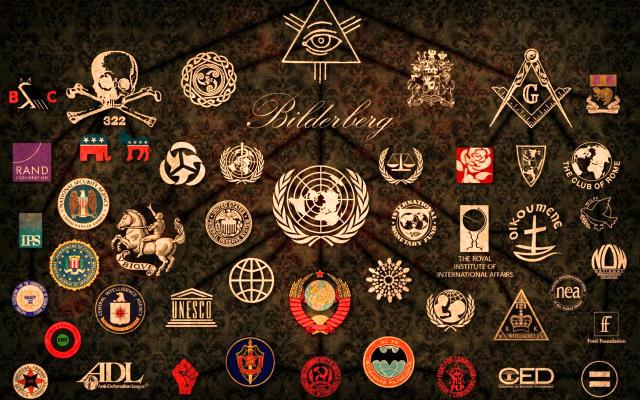
It was through their institutions that they sought to produce new
elites to manage a new society, atop of which they sat. These
universities became the harbingers of modern social sciences, seeking to
“reform” society to fit the needs of those who dominated it; to engage
in social engineering with the purpose of social control. It was in this
context that the Carnegie Corporation, the Rockefeller Foundation, and
later the Ford Foundation and others were founded: as engines of social
engineering. One of their principal aims was to shape the development of
the social sciences – and their exportation around the world to other
industrial and imperial powers like Great Britain, and beyond. The
social sciences were to facilitate the “scientific management” of
society, and the foundations were the patrons of “
social control.”
The Rockefeller, Carnegie and Ford foundations were instrumental in
providing funding, organization and personnel for the development of
major American and international think tanks such as the Council on
Foreign Relations, which became essential to the emergence of a dominant
and entrenched U.S. business class linking academia, political,
strategic, corporate and financial elites. The Rockefeller and Ford
foundations in particular constructed the field of modern political
science and “Area Studies” with a view to educating a
class of people who would be prepared to help manage a global empire.
They were also prominent in developing the educational system for
black Americans designed to keep them relegated to labor and
“vocational” training. They helped found many prominent universities in
Africa, Asia and Latin America to train indigenous elites with a
“Western” education in the social sciences, to
ensure continuity between a domestic and international elite, between core and periphery, empire and protectorate.
Another major policy planning group is the Trilateral Commission,
created out of the Bilderberg meetings as a separate transnational think
tank and founded by Chase Manhattan CEO (and Chairman of the Council on
Foreign Relations) David Rockefeller along with
academic-turned-policymaker Zbigniew Brzezinski in 1973. The Trilateral
Commission linked the elites from Western Europe, North America and
Japan (hence “trilateral”), and it now also includes members from China,
India and a range of other Pacific-East Asian countries.
Consisting of a membership of roughly 350 individuals from finance,
corporations, media, think tanks, foundations, academia and political
circles, the Trilateral Commission (TC) has been immensely influential
as a forum facilitating the development and integration of a
“transnational elite.” The aim of the TC was “to
foster closer cooperation among these core industrialized areas of the world with shared leadership responsibilities in the wider international system.”
The most famous report issued by the Trilateral Commission in the
mid-1970s suggested that due to the popular activism of the 1960s, there
was a “crisis of democracy” that it defined as an “
excess of democracy,”
which needed to be reduced in order for “democracy to function
effectively.” According to the Trilateral Commission, what was needed
was increased “apathy and noninvolvement on the part of some individuals
and groups” to counter the “crisis” being caused by “a highly educated,
mobilized, and participant society.”
Moving elsewhere, the World Economic Forum, founded in 1971, convenes
annually in Davos, Switzerland and was originally designed “to secure
the patronage of the Commission of European Communities, as well as the
encouragement of Europe’s industry associations” and “to discuss
European strategy in an international marketplace.” The WEF has since
expanded its membership and mandate, as Carroll and Carson noted,
“organized around a highly elite core of transnational capitalists (the
‘Foundation Membership’) – which it currently limits to ’1000 of the
foremost global enterprises’.” The meetings include prominent
individuals from the scientific community, academics, the media, NGOs
and many other policy groups.
Another major policy planning group emerged in the mid-1990s with an
increased focus on environmental issues, called the World Business
Council for Sustainable Development (WBCSD), which “instantly became the
pre-eminent business voice on the environment” with a 1997 membership
of 123 top corporate executives, tasked with bringing the “voice” of big
business to the process of international efforts to address
environmental concerns (and thus, to secure their own interests).
Among other prominent think tanks and policy-planning boards helping
to facilitate and integrate a transnational network of elites are many
nation-based organizations, particularly in the United States, such as
with the Council on Foreign Relations, the Brookings Institution and the
Center for Strategic and International Studies (CSIS), among many
others. The advisory boards to these organizations provide an important
forum through which transnational elites may help to influence the
policies of many separate nations, and most importantly, the world’s
most powerful nation: the United States.
The Council on Foreign Relations, founded in 1921, refers to itself
as “an independent, nonpartisan membership organization, think tank, and
publisher,” with roughly 4,700 members. It is largely based in New York
with affiliate offices in Washington D.C. and elsewhere. The CFR is,
and has been, at the heart of the American foreign policy establishment,
bringing together elites from academia, government, the media,
intelligence, military, financial and corporate institutions.
The CFR worked in close cooperation with the U.S. government during
World War II to design the post-War world over which America would reign
supreme. The Council was active in establishing the “
Grand Areas” of the American Empire, and in
maintaining extensive influence over the foreign policy of the United States.
As Carroll and Carson noted, there is a prominent relationship
between those individuals who sit on multiple corporate boards and those
who sit on the boards of prominent national and transnational
policy-planning groups, “suggesting a highly centralized
corporate-policy network.”
Studying 622 corporate directors and 302 organizations (five of which
were the major policy-planning groups: ICC, Bilderberg, Trilateral
Commission, World Economic Forum and World Business Council for
Sustainable Development), Carroll and Carson assessed this network of
transnational elites with data leading up to 1996, and concluded: “The
international network is primarily a configuration of national corporate
networks, integrated for the most part through the affiliations of a
few dozen individuals who either hold transnational corporate
directorships or serve on two or more policy boards.”
Out of the sample of 622 individuals, they found roughly 105
individuals (94 “transnational corporate linkers” and 11 others “whose
corporate affiliations are not transnational but who sit on multiple
global policy boards”) making up “the most immediate structural
contributions to transnational class formation.” At the “core” of this
network were 17 corporate directors, primarily European and North
American, largely linked by the transnational policy groups, with the
Trilateral Commission as “the most centrally positioned.” This network,
they noted, “is highly centralized in terms of the individuals and
organizations that participate in it.”
In undertaking a follow-up study of data between 1996 and 2006,
published in the journal International Sociology (Vol. 25, No. 4, 2010),
Carroll and Sapinski expanded the number of policy-planning groups from
five to 11, including the original five (ICC, Bilderberg, TC, WEF, and
WBCSD), but adding to them the Council on Foreign Relations (through its
International Advisory Board), the UN Global Compact (through its
advisory board), the European Round Table of Industrialists (ERT),
founded in 1983, the EU-Japan Business Round Table, the Transatlantic
Business Dialogue, and the North American Competitiveness Council.
The results of their research found that among the corporate
directors, “policy-board membership has shifted towards the
transnationalists, who come to comprise a larger segment of the global
corporate elite,” and that there was a growing group of elites “made up
of individuals with one or more transnational policy-board
affiliations.” As Carroll and Sapinski concluded:
“The corporate-policy network is highly centralized, at both the
level of individuals and that of organizations. Its inner circle is a
tightly interwoven ensemble of politically active business leaders; its
organizational core includes the Trilateral Commission, the Bilderberg
Conference, the European Round Table of Industrialists and the World
Business Council for Sustainable Development, surrounded by other policy
boards and by the directorates of leading industrial corporations and
financial institutions based in capitalism’s core regions.”
Organizations like the European Round Table of Industrialists (ERT)
are not think tanks, but rather, industry organizations (exclusively
representing the interests and individuals of major corporations),
wielding significant influence over political and social elites. As
Bastiaan van Apeldoorn wrote in the journal New Political Economy (Vol.
5, No. 2, 2000), the ERT “developed into an elite platform for an
emergent European transnational capitalist class from which it can
formulate a common strategy and – on the basis of that strategy – seek
to shape European socioeconomic governance through its privileged access
to the European institutions.”
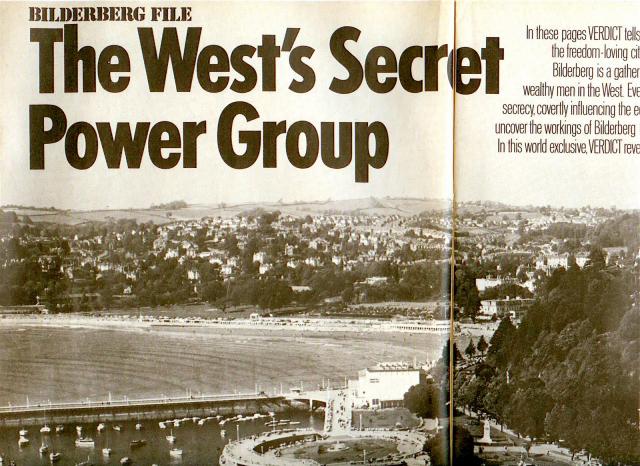
In 1983, the ERT was formed as an organization of 17 major European
industrialists (which has since expanded to several dozen members), with
the proclaimed objective being “to revitalize European industry and
make it competitive again, and to speed up the process of unification of
the European common market.” Wisse Dekker, former Chairman of the ERT,
once stated: “I would consider the Round Table to be more than a lobby
group as it helps to shape policies. The Round Table’s relationship with
Brussels [the EU] is one of strong co-operation. It is a dialogue which
often begins at a very early stage in the development of policies and
directives.”
The ERT was a central institution in the re-launching of European
integration from the 1980s onward, and as former European Commissioner
(and former ERT member) Peter Sutherland stated, “one can argue that the
whole completion of the internal market project was initiated not by
governments but by the Round Table, and by members of it… And I think it
played a fairly consistent role subsequently in dialoguing with the
Commission on practical steps to implement market liberalization.”
Sutherland also explained that the ERT and its members “have to be at
the highest levels of companies and virtually all of them have unimpeded
access to government leaders because of the position of their
companies… So, by definition, each member of the ERT has access at the
highest level to government.”
Other notable industry associations include the
Canadian Council of Chief Executives (CCCE),
formerly called the Business Council on National Issues (BCNI), a group
comprised of Canada’s top 150 CEOs who were a major force for the
promotion and implementation of the North American Free Trade Agreement
(NAFTA). The CCCE remains one of the most influential “interest groups”
in Canada.
In the United States there are prominent industry associations like
the Business Council, the Business Roundtable, and the Financial
Services Forum. The Business Council describes itself as “a voluntary
association of business leaders whose members meet several times a year
for the free exchange of ideas both among themselves and with thought
leaders from many sectors.”
Likewise, the
Business Roundtable describes
itself as “an association of chief executive officers of leading U.S.
companies with more than $7.3 trillion in annual revenues,” which
believes that “businesses should play an active and effective role in
the formation of public policy.”
Finally, the
Financial Services Forum proclaims
itself to be “a non-partisan financial and economic policy
organization” which aims “to pursue policies that encourage savings and
investment, promote an open and competitive global marketplace, and
ensure the opportunity of people everywhere to participate fully and
productively in the 21st-century global economy.”
These are among some of the many institutions which will be
researched and examined in greater detail throughout the Global Power
Project. In the next installment, I will be examining not only the
societal and economic results of these dominant institutions of power,
but the specific individuals — and in some cases family dynasties — that
wield significant influence nationally and globally.
Andrew Gavin Marshall is
an independent researcher and writer based in Montreal, Canada. He is
Project Manager of The People’s Book Project, head of the Geopolitics
Division of the Hampton Institute, Research Director for Occupy.com’s
Global Power Project and host of a weekly podcast show at
BoilingFrogsPost.





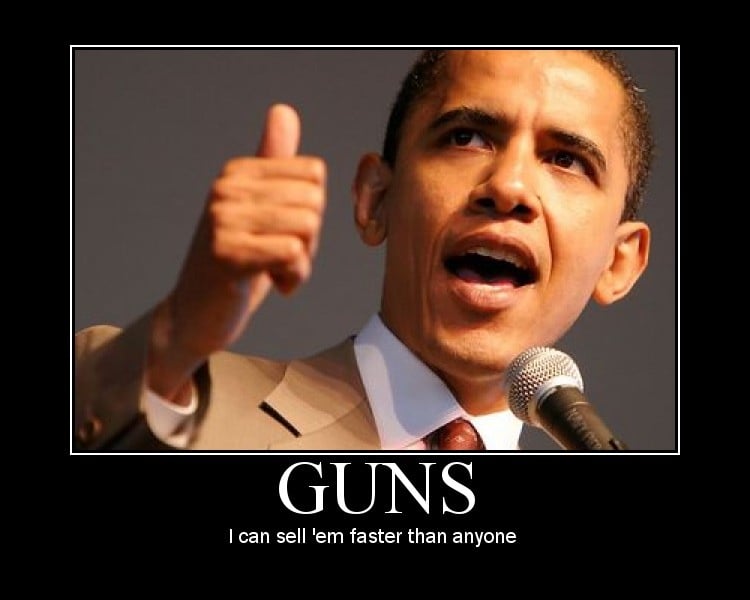
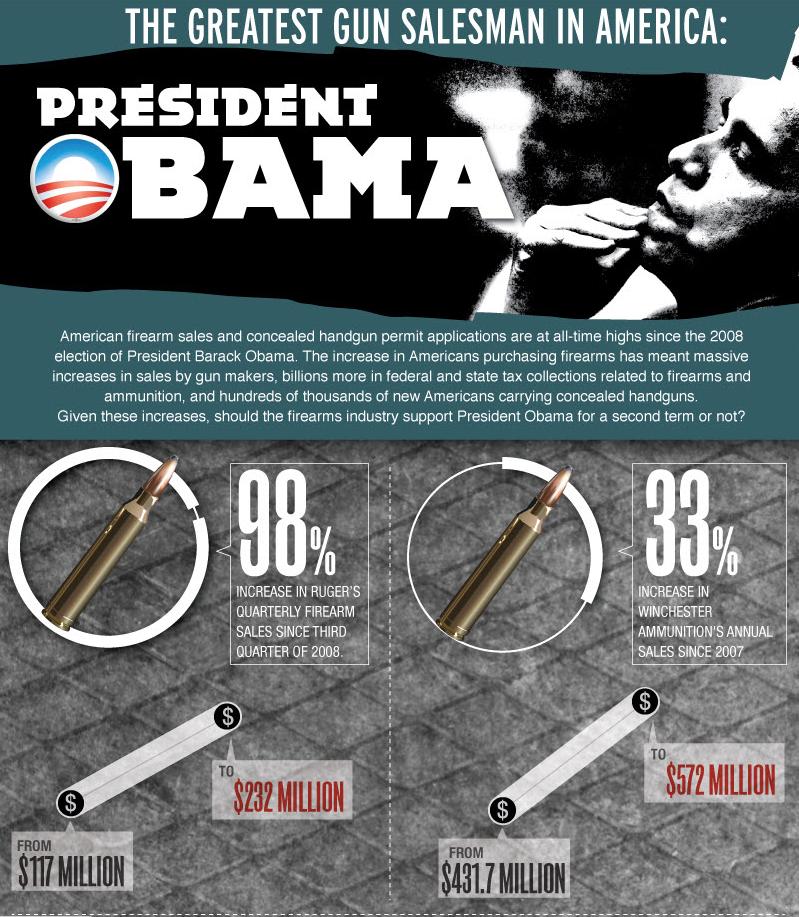 (Infographic via
(Infographic via 


